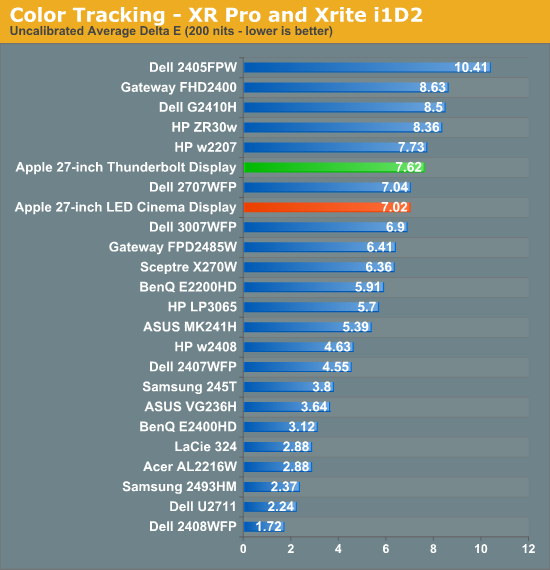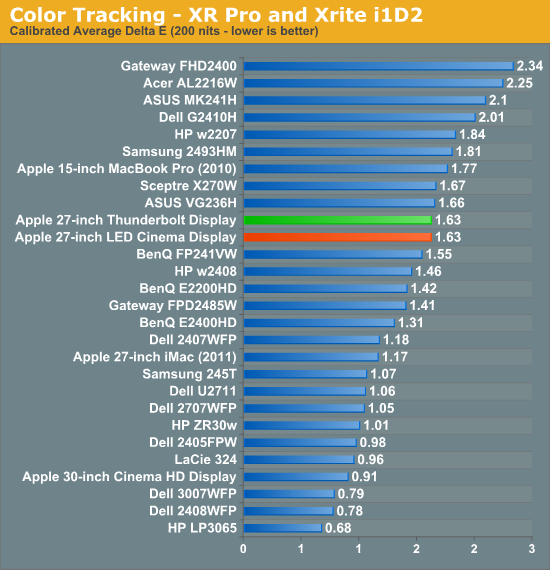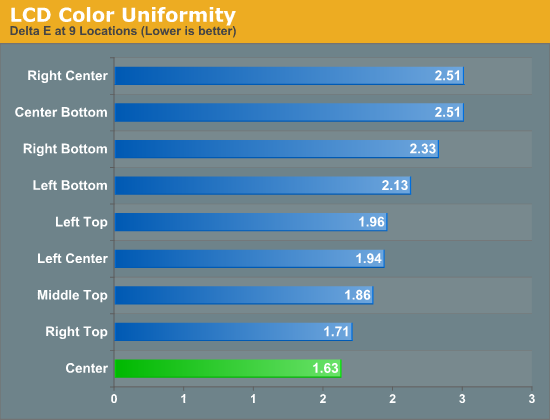The Apple Thunderbolt Display Review
by Anand Lal Shimpi on September 23, 2011 2:56 AM EST- Posted in
- Displays
- Mac
- Apple
- Thunderbolt
- Thunderbolt Display
Display Testing
With all of the extra connectivity there is to test with the Thunderbolt Display we can't forget the actual panel testing. Thankfully this part is pretty simple, the display characteristics are near identical to the 27-inch LED Cinema Display we reviewed last year.
Color Quality
We report two main quality metrics in our display reviews: color accuracy (Delta-E) and color gamut. Color gamut refers to the range of colors the display is able to represent with respect to some color space. In this case, our reference is the AdobeRGB 1998 color space, which is larger than the sRGB color space. So our percentages are reported with respect to this number, and larger is generally better.
Color accuracy (Delta E) refers to the display’s ability to display the correct color requested by the GPU and OS. The difference between the color represented by the display, and the color requested by the GPU is our Delta-E, and lower is better here. In practice, a Delta E under 1.0 is perfect - the chromatic sensitivity of the human eye is not great enough to distinguish a difference. Moving up, a Delta E of 2.0 or less is generally considered fit for use in a professional imaging environment - it isn’t perfect, but it’s hard to gauge the difference. Finally, Delta E of 4.0 and above is considered visible with the human eye. Of course, the big consideration here is frame of reference; unless you have another monitor or some print samples (color checker card) to compare your display with, you probably won’t notice. That is, until you print or view media on another monitor. Then the difference will no doubt be apparent.
As I mentioned in our earlier reviews, we’ve updated our display test bench. We’ve deprecated the Monaco Optix XR Pro colorimeter in favor of an Xrite i1D2 since there are no longer up-to-date drivers for modern platforms.
For these tests, we calibrate the display and try to obtain the best Delta-E we can get at 200 nits of brightness for normal use. We target 6500K and a gamma of 2.2, but sometimes the best performance lies at native temperature and another gamma, so we try to find what the absolute best performance could be. We also take an uncalibrated measurement to show performance out of the box using either the manufacturer supplied color profile, or a generic one with no LUT data. For all of these, dynamic contrast is disabled.

Uncalibrated performance remains fairly similar to last year's LED Cinema Display, however once calibrated the Thunderbolt Display is spot on with its predecessor:

As we mentioned earlier, a sub 2.0 delta E is good enough for professional use. Although not perfect the Thunderbolt Display falls within that range for sure.


We measured slightly lower color gamut on the Thunderbolt Display than the original LED Cinema Display, however the result was much closer to the 2011 27-inch iMac. I couldn't visibly tell any differences and Apple indicates that color gamut shouldn't have changed, so it's quite possible that the differences here are due to our colorimeter and not the panel.
Color Uniformity
Now for color consistency, we take our best calibration profile from the very center at 200 nits and test color accuracy at 9 different places around the LCD display in an evenly distributed grid. We’ve shown before that calibration is localized across the display, partly due to the brightness not being uniform, partly due to the discrete nature of the display itself.

The Thunderbolt Display was fairly uniform across its surface, something we noticed in reviewing the 27-inch LED Cinema Display last year. Uniformity is actually better on this panel than the one we reviewed last year, although in both cases I couldn't really tell any differences.
Peak brightness appears down slightly, but so are the black levels which result in a slightly better contrast ratio. Apple is also calibrating these things at the factory now so white points are now set at around 6300K vs. 7100K on the original 27-inch LED Cinema Display.










275 Comments
View All Comments
A5 - Friday, September 23, 2011 - link
No shit. Every single review, everywhere, where the hardware is provided by the manufacturer is advertising of some form. This is why you rarely see truly negative reviews of anything.ltcommanderdata - Friday, September 23, 2011 - link
And what monitors are you looking at to get those prices?http://store.apple.com/us/product/MC914?mco=MjQ1Mz...
The Thunderbolt Display is $999 not $1200.
Dell's most comparable device is the U2711 which is IPS and is $1099 regular price, although it's currently on sale for $719.
http://accessories.dell.com/sna/products/Monitors_...
I don't know how frequently Dell does sales, but at regular price the Thunderbolt Display is in fact cheaper than Dell's while including more dock features like ethernet, firewire, speakers, etc.
Stas - Friday, September 23, 2011 - link
Do a google search on the model and you will find at least 5 online sellers that have the Dell monitor for <$850Constructor - Friday, September 23, 2011 - link
Sure. The Dell doesn't have an LED backlight, however, so apparently they're selling off the old stock with CCFL backlights before moving on to LED as well.It's tougher to get a larger colour space with a (white) LED backlight, but on the other hand it's mercury-free, uses significantly less power and lives longer than CCFL.
doubledeej - Sunday, September 25, 2011 - link
CCFL backlit monitors still have a better image. That's why you find them on the high-end monitors from other manufacturers. Apple is sacrificing quality by moving to LED. Look at the charts in the article. The Thunderbolt and Cinema Display monitors both fall in the bottom third of nearly all of them. They aren't that great. LED gives better power usage, but it comes at a price in terms of image quality.Constructor - Sunday, September 25, 2011 - link
Better power efficiency, better longevity, zero mercury.Quite significant advantages.
And in most metrics the TBD is actually pretty decent, particularly for its resolution and price.
CCFL makes it cheaper to get a larger colour space than with RGB LEDs again at the very top.
But for that it's far dirtier in all three dimensions (wastes power, turns the display into e-waste a lot sooner and releases mercury if not dismantled very, very carefully – and even then the mercury remains hazardous waste).
Very few people actually have a use for an expanded colour space. Still few people actually experience limitations with brightness uniformity (my iMac 27" is fully sufficient for all my uses, with no problem noticeable). And all people benefit from the advantages.
It would have been silly for Apple to make a display that's specialized to only very few people's needs and saddling everyone with lots of disadvantages. Eizo can do that. They've got many models and they are largely specializing on these kinds of uses (and even they are on their way towards LED backlights).
jecs - Friday, September 23, 2011 - link
He went to the Apple store and confused the starting iMac to the Thunderbolt display. Some are so eager trying to look calm and cool but forget to check the facts.And you started saying "Nice but..."
Nice to what? if you did not check the real price you are objecting
Are you going to say now that you like the Apple display?
TypeS - Friday, September 23, 2011 - link
Better check the price again there bud, it's $990.00USDhttp://store.apple.com/us/product/MC914LL/A?fnode=...
The Macbook Air also starts at $990.00USD as well:
http://store.apple.com/us/browse/home/shop_mac/fam...
That's a grand total of $1980 before taxes
The 13" Pros starts at $1199 as well.
Dell lists it's U2711 at $1099 retail, with a current sale price of $949.
If we take your assumption that ASUS/Samsung have similar spec'd and functional alternatives or $900, the total savings is $150.That is a far cry from half.
Anti-apple critics are just as bad as the brainwashed Apple fanboys when they start pulling facts out of thin air.
cactusdog - Saturday, September 24, 2011 - link
The prices I quoted are from the Apple website in my country and they are accurate. Apple charge us a lot more than they do in the US.You're choosing the cheapest/smallest macbook that nobody wants and saying they are cheap. They are not. You can get a similar speced notebook for much less from Asus.
mcnabney - Friday, September 23, 2011 - link
Didn't you read the review? This display has poor color accuracy so you really can't compare it to displays that have it. Anand indicated that people accustom to laptop displays wouldn't notice it, but I guarantee that people who have historically bought and needed high quality displays WILL notice it. So you can't really compare Apple's new display to competitors that make displays for the publishing/imaging business.